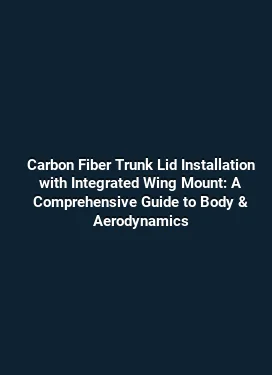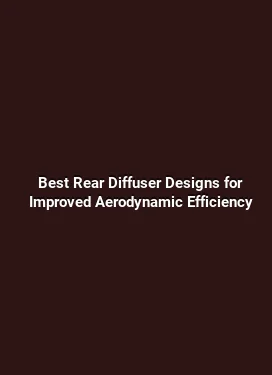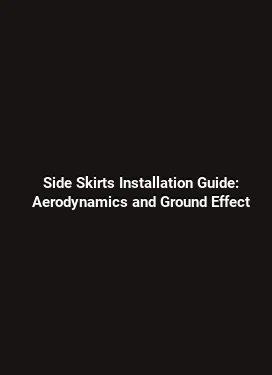Functional vs Cosmetic Rear Wing: CFD Analysis and Performance Data
Overview of Rear Wing Roles in Body Aerodynamics

The rear wing plays a crucial role in shaping the overall aerodynamic balance of a vehicle. Beyond visual styling, it contributes to downforce, stability, and cornering grip, particularly at high speeds where the boundary layer behavior around the trailing edge becomes a dominant factor. A functional rear wing is designed to generate measurable downforce with a predictable drag penalty, while a cosmetic rear wing emphasizes appearance and visual proportions with little or no intended aerodynamic benefit. In recent years, computational fluid dynamics (CFD) has become an essential tool for evaluating both approaches, allowing engineers to quantify lift, drag, and flow structures without relying solely on wind tunnel testing.
Key considerations include the wing’s planform, angle of attack, endplate geometry, and mounting position relative to the car’s rear diffuser and underbody. The interaction with the vehicle’s wake, ground clearance, and vehicle speed dictates the net effect on longitudinal and lateral stability. This section introduces the fundamental trade-offs and sets the stage for a deeper dive into numerical simulations and performance data.
Design intent and measurement criteria

When analyzing a rear wing, two primary criteria emerge: aerodynamic force generation (downforce) and drag penalty. Downforce helps keep tires planted during cornering and braking, while drag influences acceleration, fuel efficiency, and top speed. A functional wing may prioritize higher downforce at the expense of some drag, whereas a cosmetic wing often aims for visual similarity to a performance component without delivering meaningful aerodynamic gains. Similarly, the pressure distribution along the wing’s suction and pressure sides, circulation around the endplates, and the formation of tip vortices are all part of the measurable narrative that CFD can reveal.
CFD Methodology for Assessing Rear Wings
CFD analysis begins with an accurate geometric representation of the wing and adjacent vehicle surfaces. A high-fidelity mesh is generated to resolve the near-wall region, boundary layer behavior, and wake structures. Turbulence models, such as k-omega SST or large eddy simulation (LES) in more advanced studies, help predict how turbulent eddies interact with the wing. The computational domain typically includes the vehicle body, rear wing, endplates, and a patch of the surrounding air augmented by appropriate inflow and outflow boundary conditions to mirror real-world conditions.
Simulation results focus on several metrics: downforce (vertical force on the rear axle), drag coefficient, lift-to-drag ratio, and the distribution of pressure on the wing’s surfaces. Visualization of streamlines and vorticity sheds light on how endplates suppress or amplify wingtip vortices, while pressure contours illustrate regions of suction that contribute to lift. A robust CFD study uses mesh convergence checks, validates results against wind tunnel data when available, and explores sensitivity to mounting height, wing angle, and endplate width.
Mesh quality, boundary conditions, and validation
Mesh quality directly impacts result fidelity. A well-resolved near-wall mesh, with y+ values appropriate to the chosen turbulence model, ensures accurate capturing of skin friction and separation phenomena. Boundary conditions should reflect the real operating environment: a fixed vehicle speed corresponding to the target testing scenario, appropriate turbulence intensity, and realistic inflow profiles. Validation does not necessarily require identical test conditions; instead, the goal is to achieve consistent trends and magnitude ranges across several configurations that mirror practical applications.
Functional Rear Wings: Performance Characteristics from CFD
Functional rear wings are designed to maximize downforce at critical speeds, often employing adjustable angles of attack, variable endplate geometries, and optimized wing sections. CFD studies typically reveal a predictable increase in downforce with higher angles, accompanied by a corresponding increase in drag. The balance between these forces is captured by the lift-to-drag ratio, a key indicator of aerodynamic efficiency. In high-speed regimes, the impact of the wing on the vehicle’s overall drag becomes substantial, requiring calibration with underbody aerodynamics and diffuser performance to avoid compromising top speed.
Endplates play a pivotal role: they reduce wingtip vortices, lower induced drag, and stabilize the wing’s lift distribution. However, larger endplates also introduce additional frontal area and weight considerations, which can influence cooling and packaging constraints. The CFD data often show a sweet spot where modest endplate width and a carefully chosen planform yield a favorable lift-to-drag balance without overly increasing frontal drag or interference with the vehicle’s rear diffuser.
Case study: moderate-angle functional wing
A typical case examines a wing with a moderate angle of attack, a tapered aerofoil, and full-height endplates. The CFD results may indicate a meaningful downforce increase at 120-140 mph, with a drag rise that remains manageable when combined with optimized underbody flow. Pressure distribution maps reveal sustained suction near the wing’s leading edge and a favorable pressure gradient along the top surface. The wake shows a controlled vortex system that minimizes adverse interference with the diffuser, preserving overall rear-axle stability.
Cosmetic Rear Wings: Visual Appeal with Minimal Aerodynamic Benefit
Cosmetic wings are often selected for styling alignment with a brand or model lineage. From an aerodynamic perspective, many cosmetic designs produce negligible net downforce and can even disrupt the clean flow around the rear end if poorly integrated with the vehicle’s body lines. CFD evaluations focus on identifying configurations that avoid creating large pressure differentials, separation zones, or disruptive wake patterns. For these designs, the challenge lies in achieving a visually convincing silhouette while ensuring the wing does not introduce unnecessary drag or destabilizing flow features.
Several cosmetic wings incorporate features that visually imply performance, such as strakes, winglets, or cutouts, yet the overall aerodynamic effect remains limited. CFD analyses investigate how these features alter local flow structures, whether they generate small-scale vortices that travel downstream, and how the wing interacts with the trunk lid, glasshouse, and roofline. The goal is to prevent adverse spoilage of rear flow while preserving the intended aesthetic.
Aesthetic changes with measurable but limited aerodynamic impact
In practice, a cosmetic wing may include elements that slightly modify the pressure distribution or local shear stresses, yielding minor drag reductions or small shifts in downforce. CFD studies help quantify these effects, enabling designers to determine whether a visual update is worth the marginal aerodynamic cost or benefit. The resulting data often emphasizes the importance of clean integration with the vehicle’s exterior surfaces to minimize flow separation and unwanted wake interactions.
Comparison: Functional vs Cosmetic Wings Through CFD Data
Direct comparison of CFD results across functional and cosmetic configurations highlights several trends. Functional wings typically deliver higher downforce values, with a corresponding drag penalty that becomes more pronounced at higher speeds. The optimized endplates and search for an efficient lift-to-drag ratio are central to achieving performance targets without compromising acceleration and fuel efficiency. Cosmetic wings, while often compliant with design cues, usually show limited or negligible net downforce and can exhibit increased local drag if not harmonized with the vehicle’s wake dynamics.
Beyond the raw numbers, the spatial distribution of pressure and the behavior of the rear wake provide actionable insights. For example, a well-integrated functional wing may leverage a modest increase in downforce to improve rear-axle stability without significantly disturbing the diffuser’s suction peak. Conversely, a poorly aligned cosmetic wing can introduce adverse pressure gradients that wake into the diffuser region, reducing overall rear-end performance.
Guidelines for selecting a rear wing approach
Engineers and enthusiasts should consider the vehicle’s intended use, cruise speed, and required balance between stability and efficiency. For track-focused applications, a functional wing with tunable angle and well-mared endplates often delivers the best return on investment, especially when paired with optimized underbody aerodynamics. For street-driven vehicles where visual appeal is a priority, a thoughtfully designed cosmetic wing can achieve an aesthetically pleasing look with minimal performance trade-offs, provided it is carefully integrated with the car’s rear geometry and airflow patterns.
Practical Insights: Design, Testing, and Data Interpretation
Translating CFD findings into real-world gains involves iterative testing and careful interpretation of the data. A few practical steps include validating the CFD model against wind tunnel benchmarks, exploring a matrix of wing angles and endplate dimensions, and correlating aerodynamic results with vehicle handling characteristics such as yaw stability and rear-wheel traction. It is also important to consider manufacturing realities, including material selection, appealing surface finish, and tolerances that influence clean flow attachment and boundary layer behavior.
For ongoing development, a systematic approach to data capture is beneficial. Maintain a database of configurations with corresponding downforce, drag, pressure distributions, and wake visuals. Use this information to identify configurations that achieve the desired compromise between aggressive handling and acceptable drag, and apply the insights to related aerodynamic components such as roof spoilers, trunk aerodynamics, and diffuser geometries.
Interpreting CFD visuals for practical decisions
Color maps of pressure coefficients and velocity fields offer intuitive guidance: strong suction zones on the wing’s upper surface indicate potential downforce generation, while large high-pressure regions can signal drag penalties. Vorticity plots reveal how endplates and wing tips influence wake coherence. The most actionable interpretations come from linking these visuals to measurable forces and to the vehicle’s dynamic response during cornering and braking scenarios.
Conclusion-Free Narrative: The Path Forward in Body Aerodynamics
As aerodynamic design progresses, the interplay between form and function becomes increasingly nuanced. The R&D emphasis shifts toward holistic integration where the rear wing works in concert with the entire undercarriage, cooling pathways, and structural constraints. By leveraging CFD analyses, designers can explore a wide design space, quantify performance implications, and make informed choices that align visual aspirations with measurable, repeatable performance gains. The outcome is a vehicle that not only looks purposeful but also behaves with predictable stability and efficiency across a range of operating conditions.





